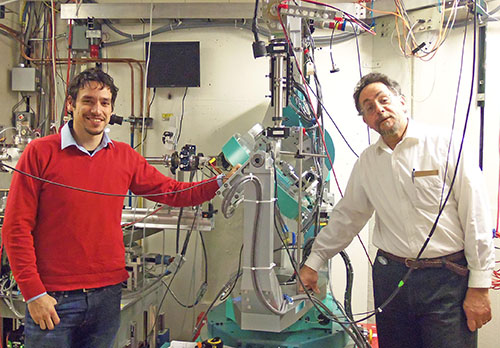X-RAY RUNS: Apply for Beamtime
2017 Nov 1 - Dec 21
2018 Feb 7 - Apr 3
2018 Proposal/BTR deadline: 12/1/17
2018 Apr 11 - Jun 4
2018 Proposal/BTR deadline: 2/1/18
CHESS just installed a new HUBER 6-circle diffractometer (illustrated below) in the C-line (bend magnet) experiment hutch. It replaces the original (30 year old) CHESS 4-circle, and provides many new capabilities. This system weighs 4600 pounds together with its support table engineered by Alan Pauling, based on an APS Sector 7 design. The table was built for CHESS in New York State, by Keller Engineering in Buffalo.
C line has the most flexible x-ray optics capability at CHESS and this new instrument will allow us to take full advantage. The independent motion of the 3-circles orienting the sample, relative to the detector arm provides freedom to define any vertical diffraction plane. This is an essential capability for surface diffraction. Together with a significant increase in detector "carry capacity" this freedom enables new scattering experiments including: inelastic scattering, advanced topographic and polarization studies, and measurements at very low temperature.
A commissioning study was done in December 2013 by Angel Rodriguez-Fernandez, a graduate student from University of Oviedo, Spain, who is visiting staff scientist Ken Finkelstein through a fellowship underwritten by Asturias, the autonomous region Angel calls home. They used a polarization analyzer to isolate and measure a unique series of diffraction resonances at the iron K-edge in hematite. The results will compliment Angel's Ph.D. studies of tensor structure factors in iron containing crystals.

Angel Rodriguez-Fernandez with Ken Finkelstein.
Submitted by: Ken Finkelstein, CHESS, Cornell University
01/08/2014
